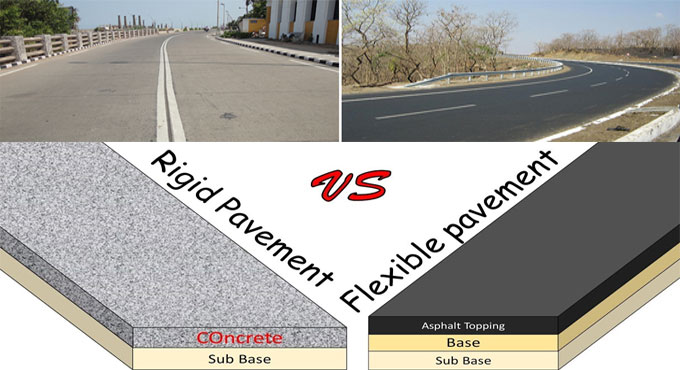
Basic difference between Flexible Pavement and rigid pavement in highway construction
Carriageway: A carriage way means the width or section of road that is utilized by the vehicular traffic for their movement. It is normally the middle section of the total land width with the arrangement of bituminous concrete or paved to offer good service for the users. Width of the carriage way is based on the number of the lanes in the road that again relies upon the class of the highway. For higher level road, more numbers of lanes are required and hence the width of the carriage way will be greater.
Pavement: Pavement stands for an open, public way for the passage or transmits of vehicles, people, and animals. Pavement is completed with a rigid smooth surface. The longevity of the pavement is increased with the smooth surface since it can sustain traffic and the environment.
The condition of road pavements deteriorates in due course of time with the effect of traffic, specifically heavy vehicles and environmental factors like weather, pollution. The main objective of the pavement is to disperse the load.
Pavements are mainly intended for the vehicles and pedestrians. The design of a pavement is significantly impacted by the storm water drainage and environmental conditions. The roads of the earlier times are entirely based on stone, gravel and sand for construction and water is applied as a binding agent to level and provide a perfect look to the surface. Generally, all hard road pavements are categorized as follow :-
Purpose of prime coat
Flexible Pavement: In flexible pavements, bituminous or asphalt materials are applied to develop the surface. It becomes flexible because the total pavement structure bends or deflects with the effect of the traffic loads. Normally, the maintenance or restoration work should be carried on each 10 to 15 years for this type of pavement.
Generally, a flexible pavement structure comprises of different layers of material. The layers include superior quality materials to be arranged on top where the volume of stress from traffic loads is extreme and lower quality materials will be placed at the bottom where the volume of stress is low.
Flexible pavements are tested as a multilayer system under loading. A standard flexible pavement structure includes the surface course and underlying base and sub base courses. Each of these layers is good for structural support and drainage.
If hot mix asphalt is employed as the surface course, it is very rigid and significantly impacts the pavement strength. The underlying layers are not so firm but are still vital to maintain pavement strength and drainage and frost protection. If a seal coat is applied as the surface course, the base generally remains as the layer that significantly impacts the structural stiffness. A standard structural design produces a series of layers that slowly reduce the material quality with depth.
Rigid Pavement: A rigid pavement structure is formed with a hydraulic cement concrete surface course and concealed base and sub base courses. The surface course belongs to the firm layer and offers the majority of strength. The base or sub base layers are orders of magnitude & less firm as compared to the PCC surface but vital for pavement drainage and frost protection and create a working platform for construction equipment.
Rigid pavements are considerably tougher as compared to the flexible pavements because of the high modulus of elasticity of the PCC ? Plain Cement Concrete material, that leads to very low deflections under loading. The rigid pavements is tested with the plate theory. Rigid pavements can contain reinforcing steel, that is normally applied to deal with thermal stresses to decrease or eliminate joints and retain tight crack widths.
The following are the basic differences among Rigid and Flexible pavement
Flexible pavement:
a. Deformation in the sub grade is transmitted to the upper layers
b. Contain low flexural strength
c. Load is transmitted to gain to gain contract
d. Contain low completion test but high repairing cost
e. It gets damaged by oil and chemicals
f. It?s design is made on the basis of load distribution factor
Rigid pavements:
a. Deformation in the sub grade is transmitted to the following Layers
b. It contains extreme flexural Strength
c. Grain to grain load transmission is not required
d. It contains low repairing cost but high completion cost
e. It is not damaged with oil or Greece
f. It?s design is created on the basis of flexural strength or slab action


